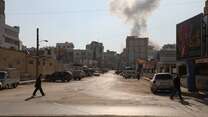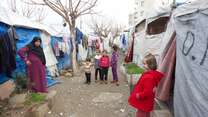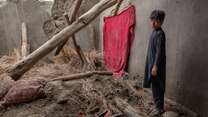Humanitarian needs in Syria remain the largest on record
- Millions of people remain displaced across the country and some 16.7 million Syrians are in urgent need of humanitarian assistance.
- Conflict continues in the northeast of the country, where shelling earlier this month damaged key water and power stations, leaving more than 400,000 people deprived of access to clean water and electricity.
- In Syria, the IRC is providing fuel, medical care, hygiene kits, and cash assistance to help communities stay warm and healthy this winter.
- We are calling for a lasting end to hostilities and conflict, increased funding from the international community and unfettered humanitarian access.
Country facts
- Population: 21.7 million
- People displaced by crisis: 12.3 million
- Rank in Human Development Index: 150 of 191
IRC response
- Started work in Syria: 2012
- People assisted: More than 1.9 million in 2023
The ongoing war in Syria has left over 15 million people in need of aid. The vast majority of Syrians live in poverty. Through programs coordinated by our teams based in Iraq, Jordan and Syria, the IRC provides emergency and long-term services to displaced families and other Syrians in need.
Since 2011, Syrian society has been torn apart by brutal violence, creating one of the largest humanitarian crises of the 21st century. Millions have fled to neighboring countries. At the peak of hostilities, many Syrians chose to risk their lives in search of safety and opportunity in Europe.
In early February 2023, a devastating earthquake sent shockwaves through communities in northern Syria, affecting large numbers of vulnerable people who resettled in the region after being displaced by conflict.
Since 2011, fighting in Syria has led to the destruction of homes, schools and hospitals— including IRC-supported facilities—and devastated life-sustaining civilian infrastructure and services including water, sanitation and electricity systems.
6.7 million people are still displaced inside Syria and 15.3 million are in need of humanitarian aid. Many civilians have been left living in perpetual conflict zones and have been displaced multiple times. Women and children are particularly vulnerable to a range of safety issues including sexual violence, early marriage, child labor, and physical and mental trauma.
Syria is also the deadliest country in the world for humanitarians. Attacks on aid workers, civilians, homes and hospitals remain common. The health system has been decimated, undermining Syrians’ ability to cope with the challenges of COVID-19, as well as the first cholera outbreak in a decade.
The recent earthquake and following aftershocks have deepened Syria’s crisis further, affecting areas that host a high number of families displaced by conflict. Coming just after the country was hit by a snowstorm, thousands have been left exposed to freezing temperatures without shelter.
The IRC has more than 1,000 staff inside Syria working to provide life-saving health care, protection and tailored support to the communities we serve. In response to the devastating earthquake, we are launching an integrated response to provide crucial support to affected populations.
This response builds on our existing programming in Syria, which has supported communities in the country’s northwest and northeast since 2012. As violence, displacement, poverty, COVID-19 and the recent earthquake wrack Syria, the IRC is escalating our response by:
- providing earthquake affected communities with necessary items, such as blankets and towels, as well as hygiene supplies, like soap and feminine products;
- supporting essential health services in earthquake affected areas;
- partnering with local and diaspora groups to ensure the uninterrupted flow of critical medicines, supplies and equipment;
- confronting cholera and COVID-19 by promoting awareness campaigns, health education and training health workers in infection prevention, management and control;
- providing food and emergency cash assistance to help displaced and earthquake affected families meet their immediate needs;
- operating clinics and mobile teams to provide lifesaving trauma services, primary and reproductive care, dialysis and essential drugs;
- integrating mental health services into our primary care work;
- running classes, counseling and protection services for thousands of children in camps and communities;
- creating safe spaces for women and girls that offer services for survivors of violence and disaster, as well as counseling and skills training;
- supporting early childhood development to reverse the harmful effects of early stress and trauma caused by crisis and displacement;
- building households’ economic stability with job training, apprenticeships and small business support;
- supporting Syrian refugees in Jordan, Iraq and Lebanon.
“Roads and infrastructure, like bridges, have been damaged meaning it will likely prove challenging to get supplies to those who need it most,” explains the IRC’s Syria country director, Tanya Evans. “Even before the earthquakes, humanitarian access was constrained in northwest Syria, with most aid coming in via one crossing point with Türkiye. In this time of increased need it is critical that the levels of aid crossing also increase at pace too.”
Over a decade has forced more than half of all Syrians from their homes, making Syria the world's largest displacement crisis. It has also left the country on the brink of economic collapse, with 75% of the population unable to meet their most basic needs.
“Many in northwest Syria have been displaced up to 20 times and with health facilities strained beyond capacity, even before this tragedy many did not have access to the health care they critically need,” says Tanya Evans, following the February earthquake.
The IRC's work here is now more critical than ever. We pledge to put the needs of those most affected by the crisis at the forefront of our efforts and to achieve measurable improvements in safety, health and economic well-being.
We will continue to support uprooted Syrians and host communities, with a particular focus on women and children. The IRC is committed to reaching the most vulnerable and hard-to-access areas throughout the country.
We will also continue to support Syrian refugees in neighboring countries. In the next several years, we’ll focus on the following areas:
Safety
People should be safe in their homes and communities and receive support when they experience harm. Women and children, in particular, should be safe in their schools, homes and workplaces.
As a global leader in safety, the IRC will continue to identify safety risks in camps and rural and urban communities. We help survivors of abuse access safe spaces, or take services to them via mobile health teams, and mobile outreach to women and girls.
We monitor risks and rights violations at the home and in the communities and help those who’ve lost civil documents safely restore papers so they can move more freely and access services. We put particular emphasis on the needs of female-headed households.
We will also train teachers to help students who have experienced physical or emotional trauma, and support caregivers with skills to parent safely under stress and conflict.
Health
People should be protected from illness and receive medical treatment when they need it. The IRC will continue to work with local health care providers to grow our network of fixed and mobile health services. We will continue to save lives, ensure safe pregnancy and delivery, and provide essential primary care and chronic disease treatment in the toughest conditions
Economic wellbeing
People should have the means to meet basic needs; they should have opportunities to earn an income and build their assets. The IRC aims to ensure that people can access food, water and shelter without falling into debt. We also promote long-term economic recovery with job training, apprenticeships and small business support.
With a commitment to gender equality, we will also help women and girls achieve the same success as men and boys.
As in all our efforts, the IRC will strive to reach more people more quickly, increase the effectiveness of our work, listen to the concerns of those affected by our work and hold ourselves accountable for results.






